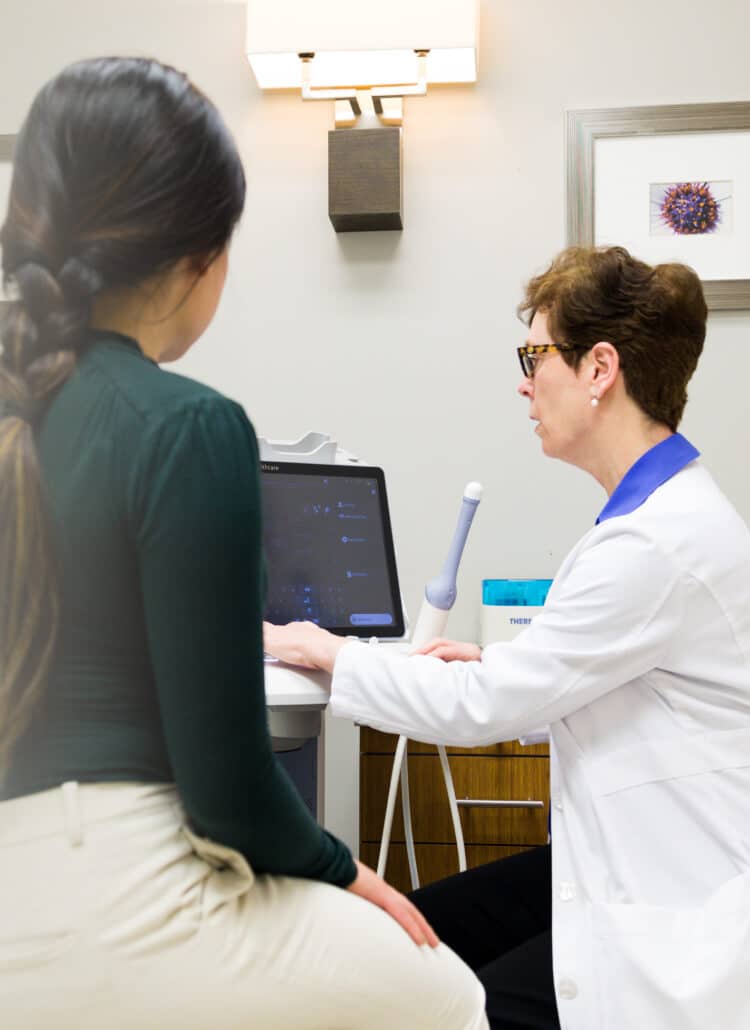Endometriosis is a highly common condition in which tissue lining the uterus (endometrium) grows outside the uterus into such areas as the ovaries, fallopian tubes, the area between the vagina and rectum and the lining of the pelvic cavity. During menstruation this excess endometrial tissue bleeds just as if it were normal tissue. Unlike normal tissue, however, it is not shed from the body, but instead becomes fixed to the area. This eventually causes inflammation, pain and scarring of the fallopian tubes, ovaries and surrounding reproductive anatomy.
Diagnosing Endometriosis
This involves an examination in which a doctor will assess frequent symptoms of endometriosis including:
- Pain before and during periods
- Pain with sex
- Infertility
- Fatigue
- Painful urination during periods
- Painful bowel movements during periods
- Other Gastrointestinal upsets such as diarrhea, constipation, nausea.
Treating Endometriosis
Endometriosis can be diagnosed with a minimally invasive surgery called laparoscopy or belly button surgery which uses a thin, lighted viewing instrument (laparoscope). The laparoscope is inserted into the pelvic area through a tiny incision made in the belly button. This process allows the doctor to look at endometrial tissue in the reproductive area. The laparoscope can also be used to surgically remove endometrial tissue.
A laparoscopy used to be a common part of the infertility work-up, especially for women with otherwise unexplained infertility. In recent years, this practice has become very uncommon for a variety of reasons, the most important being that even if endometriosis is found and treated, it tends to reoccur quickly and the improvement in fertility, if any, was minimal. Today, rather than subject all our patients to an expensive and invasive surgery, we will treat patients that might have endometriosis the same way we treat unexplained infertility patients.
On ultrasound, sometimes we can see cysts filled with cloudy fluid within the ovary. These cysts are filled with old blood and known as "chocolate cysts" as the old blood looks a lot like chocolate syrup. If we see these characteristic cysts on ultrasound, we will diagnose endometriosis. Still, surgery is not required unless there is significant pelvic pain. Some advocate removal of cysts if they show signs of growth over time or for cysts larger than 5 centimeters. There is no distinct consensus even amongst endometriosis experts on whether or not or when endometriomas should be surgically removed.
IVF and Endometriosis
In most cases of more severe and extensive endometriosis, we will advocate in vitro fertilization, to help get the eggs, sperm and embryos out of the pelvic environment, which has been shown to be toxic to these cells.
At our Northern California San Francisco Bay Area clinic, PFC's fertility doctors specialize in helping patients with endometriosis. We employ a multi-faced treatment approach and work together to create a personalized treatment plan for each patient.
Would you like to learn more about endometriosis and fertility? Join us for our next free fertility seminar!
Pacific Fertility Center® offers complimentary educational seminars hosted by our nationally recognized 'Top Docs'. You will have an opportunity to visit our San Francisco Bay Area fertility clinic, learn more about endometriosis and infertility treatment and get the chance to ask specific questions.
Some common endometriosis questions include:
- What are some of the warning signs for endometriosis?
- What are the best fertility treatment options for endometriosis?
- How much will endometriosis affect my chances of getting pregnant?
- I have many choices in Northern California's San Francisco Bay Area. Why should I choose PFC?
- And much more... We're here to answer your questions.
Pacific Fertility Center is conveniently located by Fisherman's Wharf and the Embarcadero in the San Francisco Bay Area, with convenient access from many Northern California communities. Sign Up for the next new patient seminar @PFC »
-
For some patients with endometriosis, IUI in conjunction with fertility medications is a viable option. The fertility medications help to increase the number of eggs produced in a single ovulation cycle. During ovulation, specially prepared semen is deposited into the uterus using a thin catheter. This technique is far more likely to result in a pregnancy than no treatment at all.
-
According to the most recent SART data, almost 37% of patients with endometriosis who were under the age of 35 had a successful live birth on their first attempt at IVF. The same age group had a successful live birth rate of 45.7% on their subsequent attempts. Comparatively, patients with endometriosis over the age of 42 had 0% success on their first attempt and 32.4% success on a second or subsequent attempt. However, it’s important to realize that the success of IVF in cases of endometriosis is dependent on a wide range of factors, some of which are not easy to understand when looking at plain data.
-
The need for treating endometriosis before starting IVF is highly dependent on the individual patient and the severity of the disease. For some patients, removing endometrial tissue can help improve fertility and chances of having a successful IVF cycle, but for others, excessive laparoscopic surgery can be harmful. At PFC, we consider each endometriosis case on an individual basis to determine the best course of treatment for each unique patient.



